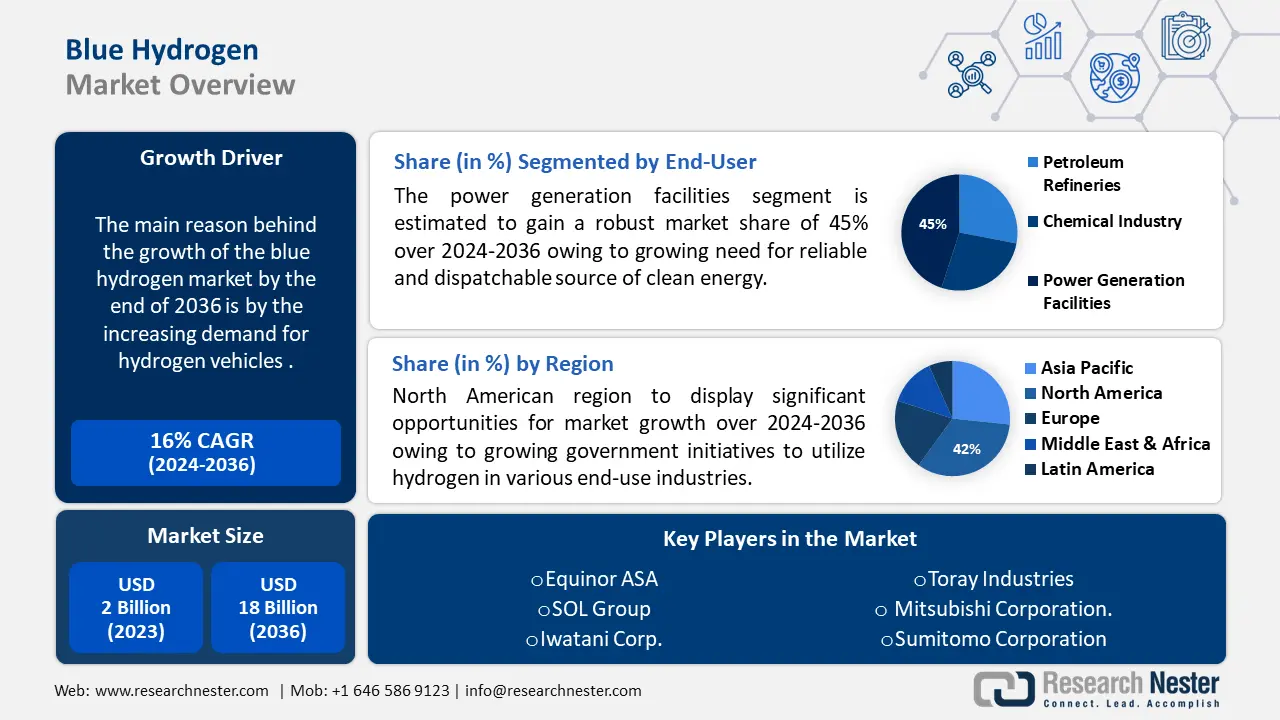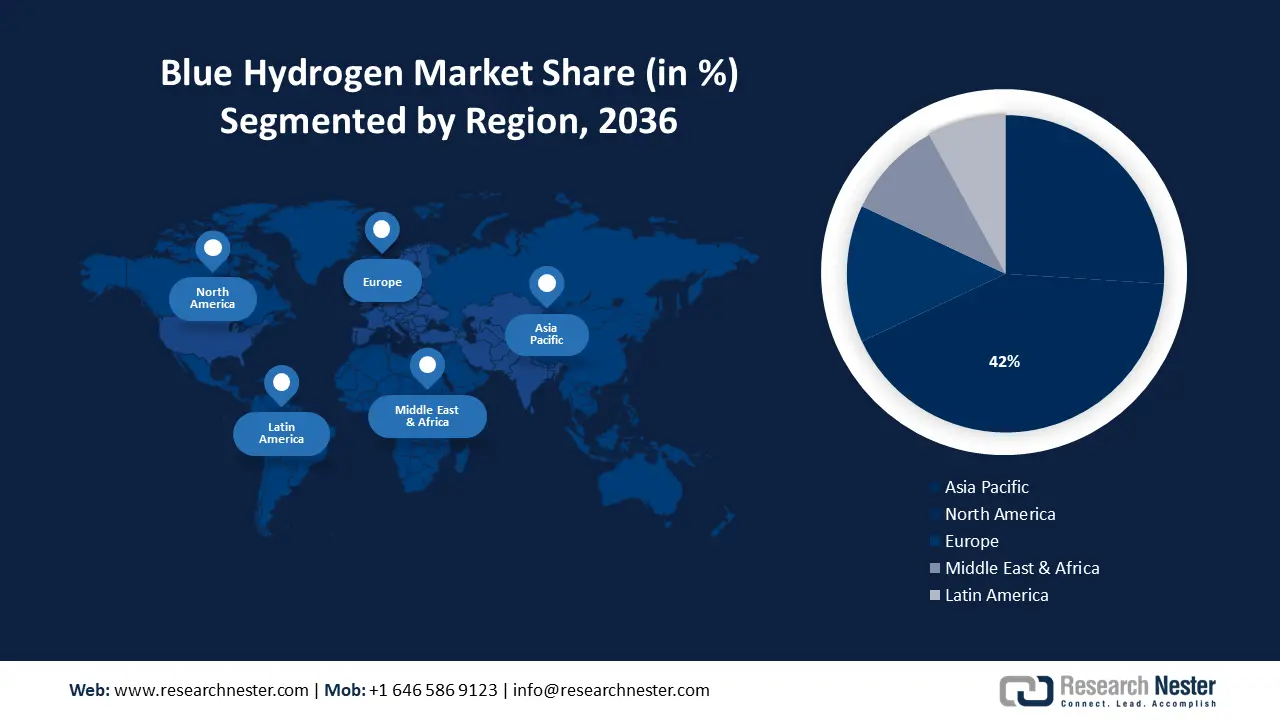
Blue Hydrogen Market size is poised to reach USD 18 Billion by the end of 2036, growing at a CAGR of 16% during the forecast period, i.e., 2024-2036. In the year 2023, the industry size of blue hydrogen was USD 2 Billion. The reason behind the growth is due to the growing production of hydrogen across the globe. Nowadays, commercial hydrogen production takes place as modern industrial consumers demand hydrogen, and also as world moves toward a net-zero energy future, it is quickly replacing fossil fuels as the preferred low- or no-carbon fuel. For instance, in 2023, global hydrogen production capacity reached to around 4 million tons per year, a 164% increase over 2022.
In addition to these, factors that are believed to fuel the market growth of blue hydrogen, the growing need for carbon capture, utilization, and storage (CCUS) technologies is believed to fuel the blue hydrogen market growth. By 2050, the demand for CCUS would be around two GTPA, over the current pipeline of projects as they have been anticipated by numerous industry professionals over the last thirty years as a necessary means of decarbonizing industries.

Growth Drivers
Challenges
|
Base Year |
2023 |
|
Forecast Year |
2024-2036 |
|
CAGR |
16% |
|
Base Year Market Size (2023) |
USD 2 Billion |
|
Forecast Year Market Size (2036) |
USD 18 Billion |
|
Regional Scope |
|
End-User (Petroleum Refineries, Chemical Industry, Power Generation Facilities)
The power generation facilities segment is poised to gain the largest market share of about 45% in the year 2036. The segment growth can be impelled by growing need for reliable and dispatchable source of clean energy. Hydrogen-fired power plant provide flexibility in balancing grid demand and can serve as backup capacity during peak periods or when renewables are unavailable.
Additionally, the decarbonization imperative is driving utilities to invest in low-carbon energy solutions, with blue hydrogen emerging as a promising option to replace fossil fuels in conventional power generation, thus driving growth in this segment.
Technology (Steam Methane Reforming, Gas Partial Oxidation, Auto Thermal Reforming)
The steam methane reforming segment in the blue hydrogen market is set to garner a notable share shortly. SMR, or steam methane reforming, is by far the most common method for producing hydrogen where methane from natural gas is heated during the process. Natural gas is converted to blue hydrogen via the method of steam methane reforming (SMR), which is a process that uses the interaction of hydrocarbons with water to produce syngas.
Blue hydrogen generation primarily uses steam methane reforming whereby in the presence of a catalyst, methane and steam react to create hydrogen at pressures between 3 and 25 bar (1 bar, or 14.5 psi). For instance, the process of SMR produces more than 90% of the hydrogen produced worldwide. Particularly, in the US over 94% of the hydrogen produced in the US comes from steam methane reforming, which is the most extensively utilized method for producing bulk gas.
In addition, the main goal of partial oxidation (POX), a particular kind of chemical reaction, is to create hydrogen. Compared to steam reforming (SR), partial oxidation of methane (POX) has greater potential for producing syngas and is extremely adaptable, having been used with lignite, bituminous materials, natural gas, propane, butane, and various petroleum distillates and residues.
Furthermore, combining the partial oxidation reaction with the steam reforming reaction is known as auto thermal reforming which is the process of creating hydrogen by using less energy than other methods since it produces syngas, which is a mixture of hydrogen, carbon monoxide, and carbon dioxide.
Our in-depth analysis of the market includes the following segments:
|
Technology |
|
|
Transportation Mode |
|
|
End-User |
|
North America Market Statistics
Blue Hydrogen market in the North American region is estimated to hold the largest with a share of about 42% by the end of 2036. The market growth in the region is also expected on account of growing government initiative to utilize hydrogen. Around USD 7 billion has been set aside by the US government to aggressively support the construction of hydrogen hubs, or H2Hubs, around the nation that will employ several production techniques, denoted by colors such as pink, blue, and green hydrogen. Besides this, to spur the US clean hydrogen market, the use of clean hydrogen to power heavy industries such as aluminum and steel is being emphasized.
In addition, nearly all hydrogen produced commercially in the US is created via steam-methane reforming where natural gas is the main methane source for hydrogen synthesis. Moreover, large central plants that reform natural gas create more than 90% of the hydrogen produced in the United States today. For instance, the United States produces over 9 million metric tons of hydrogen yearly, or slightly more than 1 quadrillion BTUs.
European Market Analysis
The European region will also witness huge growth for the blue hydrogen market during the forecast period and will hold the second position led by the growing focus on sustainability. Numerous efforts to support sustainable development and enterprises have been put into place as a result of the new EU growth strategy's emphasis on sustainability, such as the European Green Deal, which seeks to achieve carbon neutrality for the EU by 2050. The EU has set high goals to boost the use of renewable energy sources and cut greenhouse gas emissions, has also made significant investments in environmentally friendly transportation, and has instituted laws and programs to bolster companies that are dedicated to sustainability.
Additionally, blue hydrogen contributes to enhancing energy security and diversification by reducing dependence on imported fossil fuels. By utilizing domestic natural gas resources and investing in hydrogen production infrastructure, European countries can strengthen their independence and resilience to supply disruptions, as a result all these factors culminatively contribute the market growth.



Author Credits: Payel Roy, Dhruv Bhatia
Copyright © 2024 Research Nester. All Rights Reserved

FREE Sample Copy includes market overview, growth trends, statistical charts & tables, forecast estimates, and much more.
Have questions before ordering this report?